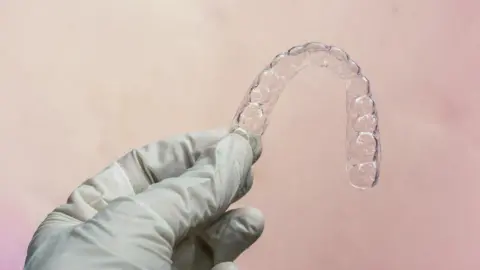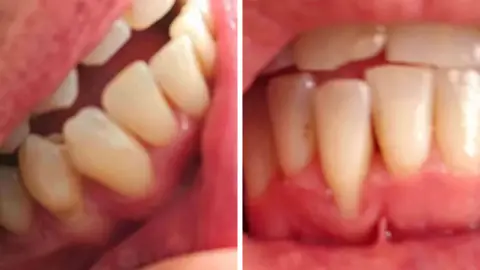Dentists warn of permanent damage from clear braces ordered online
 Getty Images
Getty ImagesDentists have told the BBC that demand for Instagram smiles has left people with damage from wearing clear braces or "aligners" ordered online.
One man said aligners weakened his front teeth, leaving him unable to bite into an apple.
Smile Direct Club, the largest company selling clear aligners remotely, says they straighten teeth faster and cheaper than traditional braces.
Its aligners have been successful for the majority of users, it says.
But some dentists and orthodontists believe customers of so-called remote dentistry are unaware of harm that can be caused by aligners if not fitted by a dentist in person.
Jamie, a father from Glasgow, turned to Smile Direct Club (SDC) after being quoted £4,000-£6,000 for straightening his teeth.
The US-based remote orthodontics company was offering clear aligners for about £1,800 without the need to see a dentist in person.
According to SDC, its platform has improved access to oral care and "has enabled successful treatment for more than 1.8 million people". The "overwhelming majority" of users have had an "excellent experience".
Wobbly teeth
But Jamie now says he would never do it again.
"I can't bite into an apple because I can't trust that my front teeth are strong enough any more," he says.
Before starting treatment he was sent a DIY impression kit to take his own teeth moulds. The other option, a 3D scan of his mouth done in an Smile Direct Club shop, was unavailable because of lockdown.
Within weeks he'd received a six-month course of aligners, with the name of the dentist overseeing him labelled on the box.
But after six months, he posted on Reddit: "One of my front teeth has become wobbly, my enamel feels all funny, like the aligners have rubbed some of it off, the aligners have made my gum recede making it agony."

In traditional dentistry, train-track braces and clear aligners are fitted by dentists and orthodontists themselves, or a trained orthodontic therapist, after an in-person consultation.
The health of the hard and soft tissues of the mouth, the teeth and gums, and whether the roots of the teeth can sustain movement, are some of the factors dentists consider. X-rays are instrumental in this process.
Once someone starts wearing braces, regular appointments allow dentists to monitor how teeth are moving and to spot and address complications.
SDC's website says users will "have regular virtual check-ins" with a UK-registered dentist "remotely from beginning to end" - but Jamie says he was not once connected to the dentist overseeing him or told to see a dentist about his issues.
Customer service eventually put him in touch with a "dental expert" via web chat, who said the issues were normal and would subside. It's unclear what qualifications are required for this role.
Dental disruptor
Jamie was encouraged to continue wearing the aligners.
SDC styles itself as a disruptor to the "bricks-and-mortar" dental industry. It argues many dentists and orthodontists offer Invisalign - a popular brand of clear braces - as a product, and therefore compete with SDC.
Some positive testimonials by SDC users on YouTube say they were put off by Invisalign's cost and the longer length of treatment offered. One customer who used SDC to correct minor teeth crowding said that the treatment "worked really well" and improved her appearance and confidence.
But, Jamie isn't alone. Hundreds of SDC users around the world have shared negative experiences on social media and dozens of users and dentists we spoke to detailed issues ranging from aligners fitting poorly to permanent nerve damage and tooth loss.

Dentist Dr Victoria Sampson says users may underestimate the force aligners put on teeth. If decay or gum disease is missed in a physical check-up, people risk losing some of their teeth.
She says she has treated someone who lost their front tooth after using the aligners because they moved her teeth too quickly, skewing her bite. The roots of the patient's teeth were too short to withstand the pressure from aligners, which would have been picked up in an X-ray.
According to UK dental associations, 3D scans and DIY teeth moulds used in remote orthodontics are not sufficient for approving aligners.
"You want to create a beautiful smile, but you also want to create a healthy smile,'' says Dr Anjli Patel at the British Orthodontic Society. The results could be "disastrous" if the teeth aren't monitored properly.
The British Dental Association's Dr Eddie Crouch is concerned SDC customers are being left to decide whether to go ahead with treatment without the right information.
The BBC showed Dr Crouch three SDC plans - a 3D interactive image of teeth that maps how they could move during treatment - presented to potential customers. He said two showed visible signs of gum disease, meaning the aligners could "loosen the teeth sufficiently to cause tooth loss".
The third plan, if accepted, he said, could leave that person with an unstable bite.
SDC says it is the user's "responsibility to see a dentist" and receive a clean bill of health for their teeth and gums within six months of starting treatment. Potential risks for patients, including nerve damage, gum disease and tooth loss are also listed.
However, patients don't have to provide proof they have seen a dentist, and under contracts they sign are fully responsible for damage.
SDC says its affiliated dentists and orthodontists are entirely responsible and accountable for the treatment they provide. There is no clinical evidence an office visit is necessary for the same level of care, it adds.
However, customers expecting the same level of care as those getting traditional braces "aren't fully informed of what they're buying into," says Dr Anjli Patel.
Few orthodontists would provide an assessment for remote treatment they don't oversee: "You have no control over what's going to happen next".
Non-disclosure contracts
Some of the users we spoke to who experienced damage have been asked to sign non-disclosure agreements to receive full or partial refunds.
Patients are requested to sign a confidentiality clause when they seek refunds outside of their refund policy, which is in line with standard industry practices, SDC says.
The General Dental Council (GDC), responsible for regulating UK dentists, says there is no effective substitute for an in person clinical examination, which should take place before treatment is prescribed. It urges consumers to consult its guidelines.
However, Dr Crouch of the BDA believes such guidelines are insufficient compared with "rules and regulation to protect patients". Otherwise, dentists will be left picking up the pieces when "patients have undergone wholly inappropriate treatment".
The UK's health watchdog, the Care Quality Commission (CQC) announced last summer any company providing remote orthodontic services will have to register with it.
Nearly two years on from his first treatment plan Jamie has stopped wearing his Smile Direct Club aligners.
He was persuaded to try a fresh 3D scan for better-fitting new aligners, but that didn't work for him, he says.
After months of negotiation he has received a full refund, but not without signing a contract that prohibits him from "creating a negative impression" of SDC's "business reputation".
"It's my naivety, I should have known that [plan] was far too quick."

Have you been affected by the issues in this story? Share your experiences by emailing [email protected].
Please include a contact number if you are willing to speak to a BBC journalist. You can also get in touch in the following ways:
- WhatsApp: +44 7756 165803
- Tweet: @BBC_HaveYourSay
- Upload pictures or video
- Please read our terms & conditions and privacy policy
If you are reading this page and can't see the form you will need to visit the mobile version of the BBC website to submit your question or comment or you can email us at [email protected]. Please include your name, age and location with any submission.

